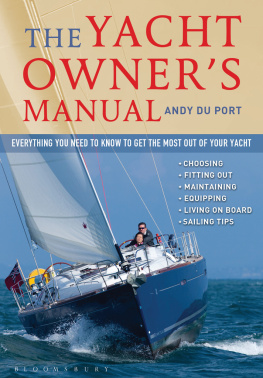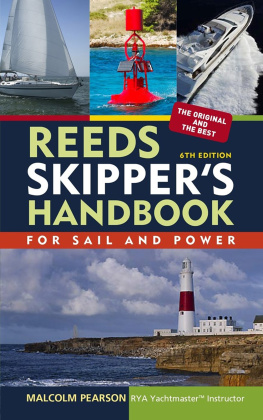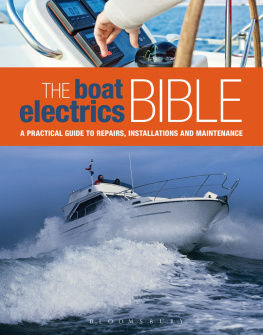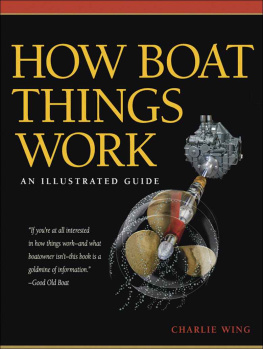

Published by Adlard Coles Nautical
an imprint of Bloomsbury Publishing Plc
50 Bedford Square, London, WC1B 3DP
www.adlardcoles.com
This electronic edition published in 2013 by Bloomsbury Publishing Plc
Copyright Bill Johnson 2011
First edition published 2011
Print ISBN 978-1-4081-3211-1
ePub ISBN 978-1-4081-5941-5
ePDF ISBN 978-1-4081-5126-6
All rights reserved
You may not copy, distribute, transmit, reproduce or otherwise make available this publication (or any part of it) in any form, or by any means (including without limitation electronic, digital, optical, mechanical, photocopying, printing, recording or otherwise), without the prior written permission of the publisher. Any person who does any unauthorised act in relation to this publication may be liable to criminal prosecution and civil claims for damages
The right of the author to be identified as the author of this work has been asserted by him in accordance with the Copyright, Designs and Patents Act, 1988.
A CIP catalogue record for this book is available from the British Library.
Note: While all reasonable care has been taken in the publication of this book, the publisher takes no responsibility for the use of the methods or products described in the book.
Visit www.bloomsbury.com to find out more about our authors and their books. You will find extracts, author interviews, author events and you can sign up for newsletters to be the first to hear about our latest releases and special offers.

AUTHORS NOTE
The principle that guides the advice in this book is: Does it work? Radically different manoeuvring techniques may or may not work in different circumstances and with different yachts, and as a general principle there is no single right or wrong way to do something.
By the same token Im in no position to accept any responsibility if, when trying these manoeuvres, something doesnt work. That, Im afraid, remains the responsibility of the skipper.
I claim no originality for the methods and tips in this book, and Im deeply indebted to the many fellow sailors who have discovered these techniques and passed them on via others to me. The book is one means of continuing this process, and Id very much like to hear from anyone who has additional techniques and advice to offer.
Many thanks to Ash Woods who, as well as being one of the people who has instructed me, took the time to review the manuscript of this book and pass on some excellent advice.

The aim of this book is to give skippers, helmsmen and crews more confidence in handling a yacht under engine.
Manoeuvring a large boat at close quarters with other boats and hard objects can be quite tricky and stressful, particularly for a new skipper. When you start to skipper a yacht, most of your mistakes can be made out in open water, well away from an audience (apart from your own crew) and hard objects that could damage the yacht if it goes wrong. It doesnt matter if you travel half a mile whilst figuring out why the mainsail is jammed: if theres plenty of space, you can take time to sort things out. But manoeuvring is a little different: if things go wrong you have to think fast. Why did that happen? What do I do now? And its not helped by the fact that helpful advice is frequently available generally in conflicting forms from onlookers.
In this book you will find solid, practical advice about how to approach the various situations you might encounter. You will find tips on how to keep control of the situation and minimise the unpredictability of each manoeuvre.
The first step is to understand whats going on and why the yacht behaves as it does. Well look at the yacht and its controls (engine, propeller, rudder) and see what they do and how they can be used to control the boat. Then well look at the wind and tide the biggest variables you need to contend with and see in detail how they affect the yacht and why.
After this well consider, in turn, all the situations that you might have to deal with, and recommend the best techniques and approaches for each one. Each manoeuvre is explained clearly and simply, with a diagram and helpful tips where relevant for the different situations. The book is arranged so that you can use it as a reference. As you read through each scenario, the intention is that you will understand why the various manoeuvres work so that you can remember them and adapt them for slightly different circumstances.
Where possible the advice is to take it slowly and retain the maximum amount of control over the yacht in case anything unexpected happens. If things are done in a rush theres far too much scope for something to go wrong, and the consequences are generally much more dangerous if the boat is moving too fast. Nothing is more embarrassing than a slick manoeuvre that doesnt work as planned so never try to show off when manoeuvring!
With confidence comes the satisfaction that youre in control of the situation. You can use this book to plan and prepare manoeuvres, and use your understanding of the yachts behaviour to adapt to different circumstances.
Good luck and good boating!
Typical Yacht
shows the design of a typical modern cruiser/racer yacht with:
a short, deep keel
a large spade rudder
a propeller mounted on a shaft.
Not all yachts are the same, and you may encounter variations on this:
Propellers
The propeller may have two or three blades theres no difference for manoeuvring. There are several designs of propeller which fold or feather in order to reduce the drag when sailing. With these there may be a short delay while the propeller unfolds or unfeathers, because it may need to start spinning first. This delay can be noticeable when manoeuvring particularly if youre moving towards a hard object and in urgent need of slowing down. Anticipate this delay.
Sail Drive
In this arrangement the propeller is mounted on a shaft-and-gear housing which extends vertically from the bottom of the hull, resembling the bottom part of an outboard motor.
Sail drive yachts will not normally experience so much prop walk (see ), mainly because the propeller is mounted further forward and closer to the turning centre of the yacht. In all other respects the performance will be identical.
Skeg-hung Rudder
These rudders tend to be smaller than the typical spade rudder, and consequently they have less turning power. In all other respects their behaviour will be identical.
Long Keel
This design is more unusual on modern yachts. The effect on manoeuvring is that the yacht will not turn so quickly, nor will the bows blow away from the wind so readily.
In addition, long-keeled boats can be difficult to reverse. The combination of significant prop walk, small rudder and heavier displacement means that the yacht can turn quite a lot before she picks up enough speed to answer to the rudder in reverse.

Next page




















